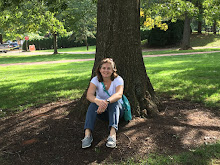In our studio practice, when interest in working clay with hands begins to wane, we bring out our popsicle sticks. There are many uses for this simple tool and it quickly becomes a favorite activity to stick the sticks in the clay. Children dicover that they can make birthday candles, forests, porcupines and all kinds of things with the sticks stuck in a lump of clay.
In our Friday Art Explorers class last week, things took a bit of a different turn as the children explored turning the lump of clay over so the sticks served as legs holding up the clay.
What began with the delight in holding a lump of clay on a stick (above) turned much more complex when more sticks were added and arranged as legs for the clay (below).

Interest in this process caught on with a nearby artist at another table.

Here she explores balance rocking the clay on its legs and getting the feel for how to make the clay stand up on the legs.

The stability of the legs of this creation allowed the artist to press spikes into the lump of clay without threatening the balance.
And here's a creation from our Tuesday class; it's a spider and it's scary!

